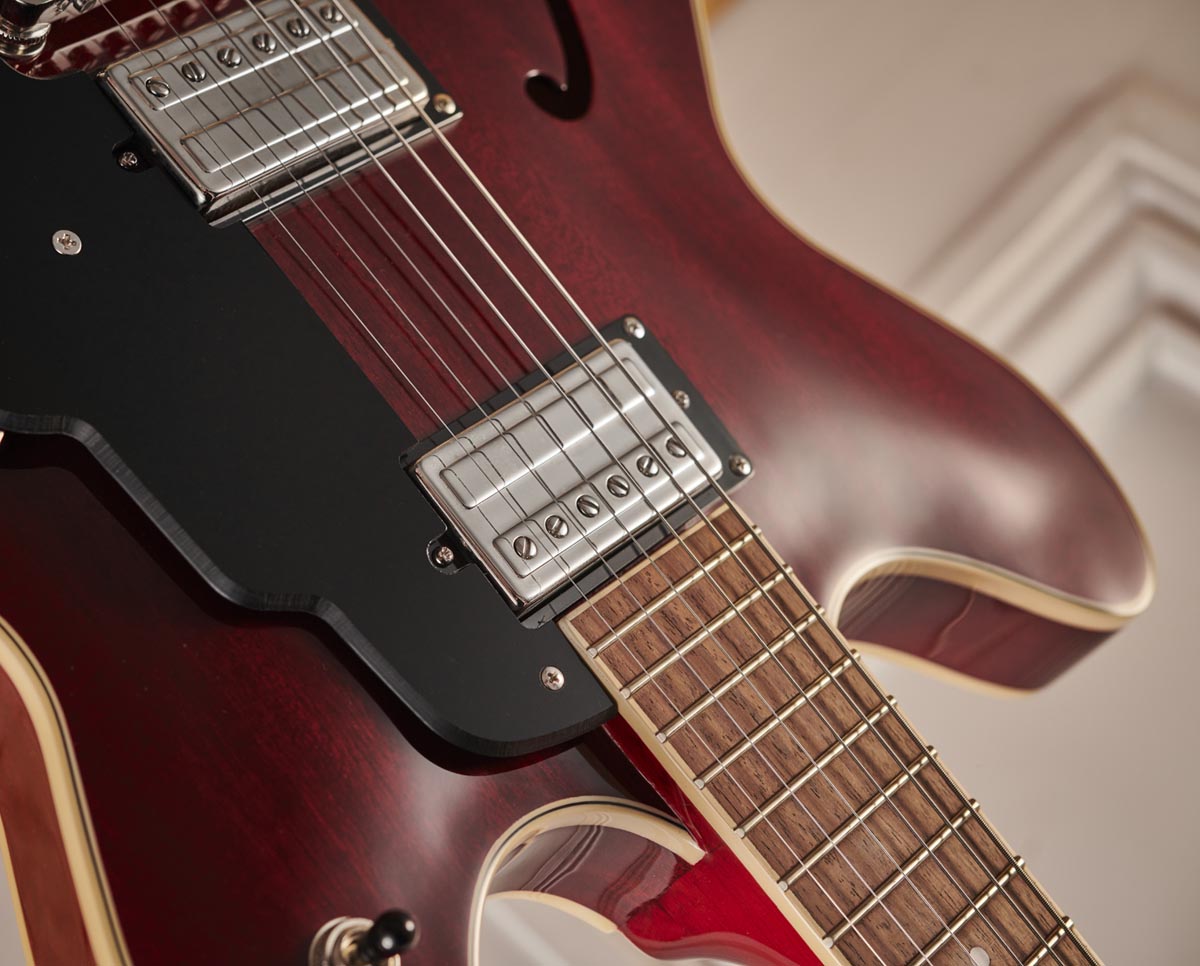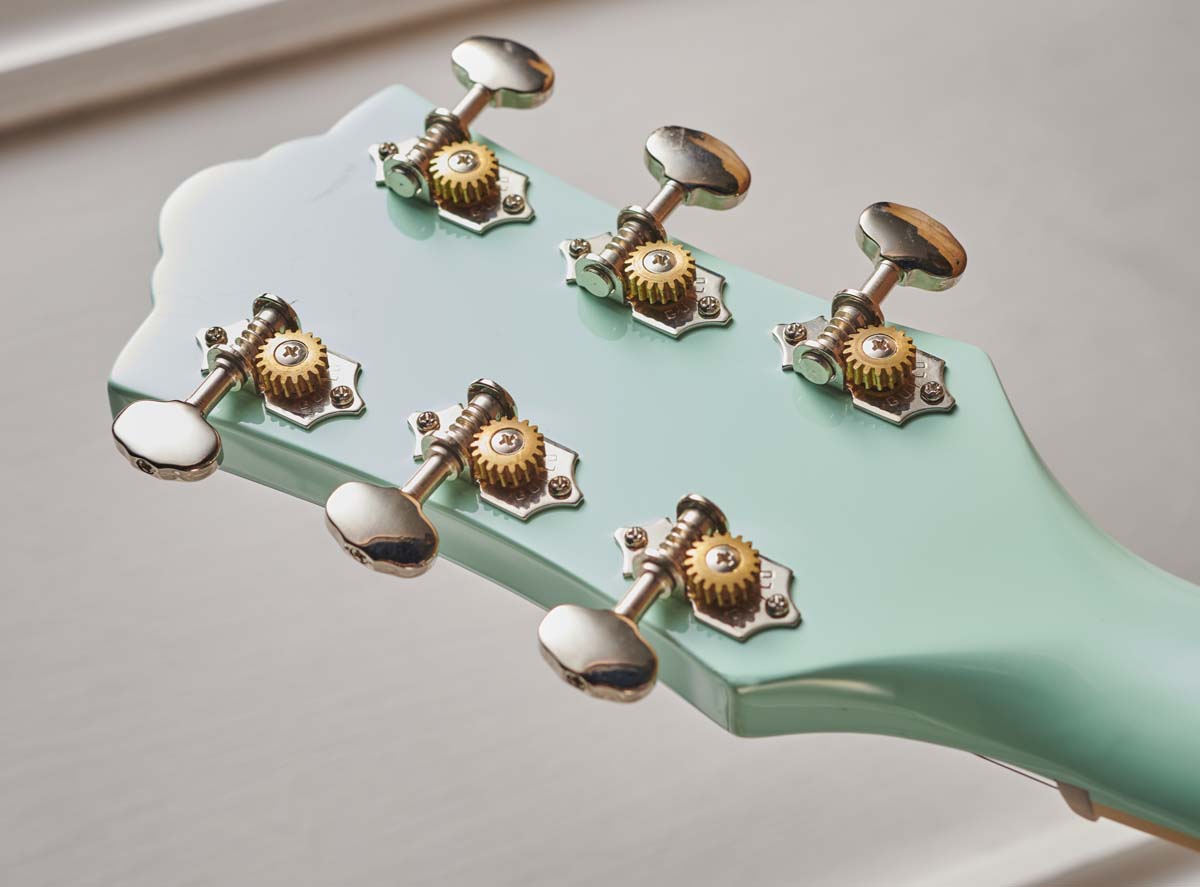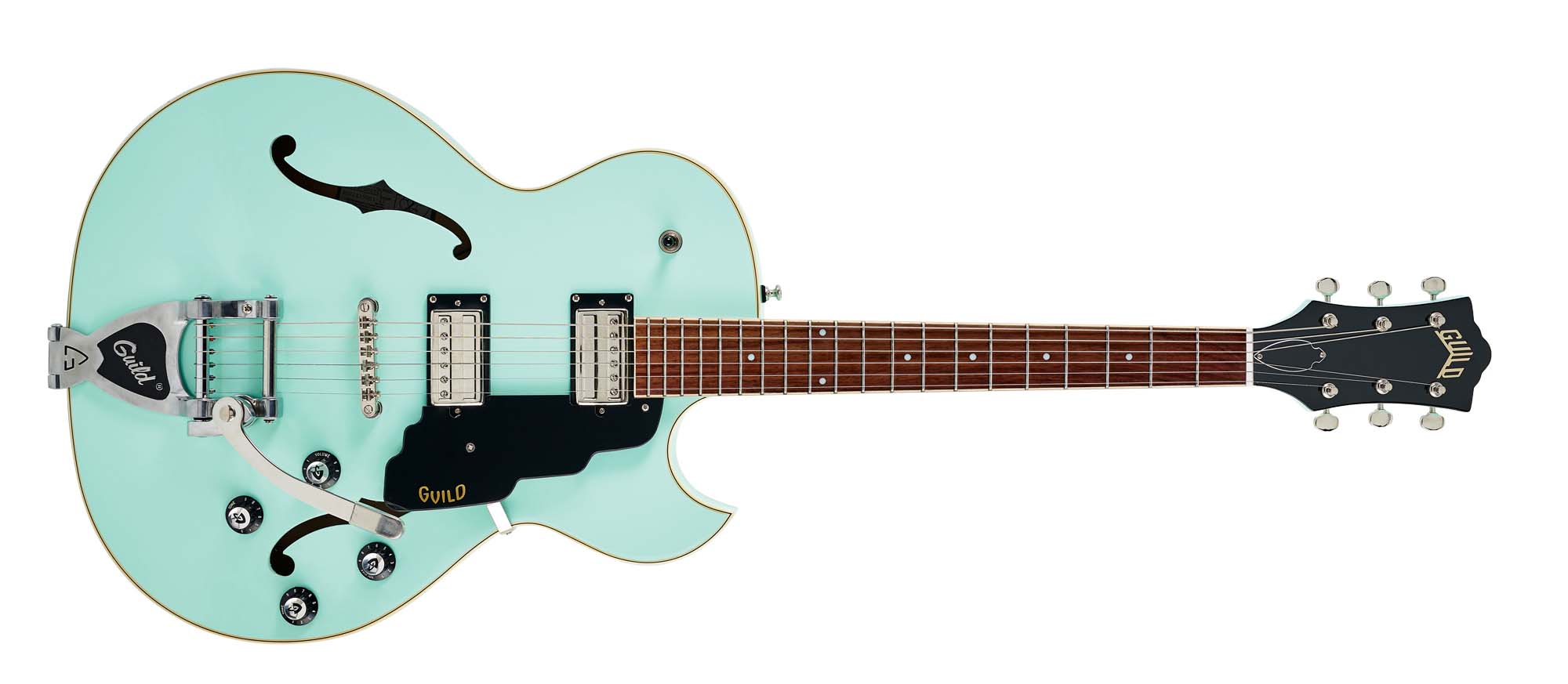Guitar World Verdict
They might not be historically accurate but the Guild Starfire I DC and I SC GVT have a vintage charm in abundance that will appeal to modern players look for affordable refinement, and a versatile ride through jazz, blues and rock 'n' roll styles.
Pros
- +
Nice build for the price.
- +
Good weight.
- +
Classic voice with coil-splits.
- +
The I SC GVT suits the coil-splits and has a more characterful sound.
Cons
- -
A little TLC in final setup would be welcome.
- -
You’ll need a case.
You can trust Guitar World
Guild is on a bit of a roll this year and you can’t help wondering if it has a crystal ball. The company’s 2020 launches could have focused on some high-end USA-made versions of its almost-classic guitars from yesteryear, but instead the folk at Guild have given us some highly affordable – but still very Guild – electric guitars.
These arrived in the form of the Aristocrat HH and P-90 models we looked at back in issue 460, plus the even more affordable “semihollowbody” versions of the Starfire models we have here, which are considerably less expensive than the existing models. Guitars for these times? Quite possibly.
Back in the day, the Starfire range that appeared in 1960 was an obvious example of Guild trying to catch up: a ‘jazz guitar’ maker suddenly in the midst of the rock ’n’ roll revolution.
There were originally three single-cut Starfire models: the single-pickup I, the dual-pickup II and the dual-pickup with vibrato III. They were based on the T-100, the first sharp-pointed ‘thinline’ hollowbody Guild that appeared in 1958 – and that was more than a nod to the Gibson ES-225TD from 1956.
Back in the day, the Starfire range that appeared in 1960 was an obvious example of Guild trying to catch up: a ‘jazz guitar’ maker suddenly in the midst of the rock ’n’ roll revolution
Bearing in mind Gibson had introduced the groundbreaking ES-335 two years before, these original Starfires almost seemed to ignore the change in musical and cultural climate.
Even when Guild introduced the double-cutaway dual-pickup IV (its ‘ES-335’) and the dual-pickup with vibrato V in 1963, they still featured the old-style ‘jazz’ wooden bridge. A posher Starfire VI came out a year later and the XII 12-string was added in 1966 – five years after relative neighbour Danelectro had released its own






A Slight Return
While Guild’s current Newark St Starfires stick pretty close to the historical blueprints, these new Starfire Is are not a recreation of the original single-pickup model.
All the latest guitar news, interviews, lessons, reviews, deals and more, direct to your inbox!
Instead, Starfire I is a catch-all name for a considerably more affordable mini-series. The SC is effectively a Starfire II, while the SC GVT with vibrato is modelled after the Starfire III. The hardtail double-cut DC, then, mirrors the Starfire IV ST, and the DC GVT apes the Starfire V.
To add a little spice, a third-style Starfire I was added mid-year, the Jet 90, which has three P-90s, vibrato, a very funky six-a-side headstock and choice of three satin colours – gold, black and white. Its dollar price is the same as the GVT models we have here. But how come they’re so affordable?
While the upper-market II and upwards Starfires are Korean made (the Aristocrat HH and P-90 models hail from China), the Starfire I models switch to the Samick factory in Indonesia.




Each model is available hardtail with a direct-mount tune-o-matic and stud tailpiece, and in that GVT version with a Guild-logo’d vibrato based on (and presumably licensed from) Bigsby’s B70 with its front-placed roller tension bar.
According to the spec sheets, further differences between the SC and DC models are the materials: the SCs use laminated maple for the front, back and sides, and solid maple for the neck; the DCs swap to mahogany – more like those original Starfires.
Peering through the unbound f-holes of both, that certainly looks correct, but there’s another more fundamental difference. The SC has a two-piece block directly under the bridge, the top portion stretching back under the front of the vibrato so the vibrato and tune-o-matic can be firmly mounted into solid wood (like the III).
The DC has a full ES-335-style centre block (like the IV and V) that appears to be solid mahogany. In terms of size they’re pretty similar: the SC is 419mm (16.5 inches) across its lower bouts, the DC marginally thinner at 416mm (16.38 inches).


The different construction also has a similarly marginal effect on the weights: the SC is slightly lighter at 3kg (6.6lb), the DC weighs 3.15kg (6.93lb). Yet another subtle difference is that the more-hollow SC is also slightly deeper: 50mm at the rim as opposed to the 46mm of the DC.
While both are extremely manageable for their styles, the historically earlier style of the SC means its 20-fret neck joins the body at the 14th fret; the later style of the 22-fret DC joins at the 18th fret. You don’t need us to tell you which is more accessible and comfortable in higher playing positions.
Our SC’s Seafoam Green will undoubtedly evoke a Marmite-like reaction – just remember you have a choice of Snowcrest White or Antique Burst, too – but it’s an opaque colour, which means outwardly there’s no way to comment on the materials used.

Still, through the trans cherry colour of the DC you can see the wood grain and that distinct striping to the body. The neck is a lighter colour and you can also see a heel stack and head-splice just in front of the lower two tuners.
The DC’s body laminate is slightly thinner compared with the SC – which we’d guess indicates three-ply as opposed to the SC’s five-ply. Like the Aristocrat HH, we get a pair of the HB-2 humbuckers (standard-sized versions of the slightly large HB-1) with just a single height-adjustment screw on the bass side.
They are spec’d with Alnico 2 magnets and DCRs of 7.35/3.69kohms for the full/split-coils of the SC’s bridge; 7.25/3.65kohms on the DC. The neck pickups on both measured the same 7.01/3.56kohms, which drops them into vintage underwound territory for their style. Tapping the pickups plugged in we’d guess they’re potted, too.
The hardware on both appears typically Asian in style, although the near generic tune-o-matic bridge has easy-to-adjust slot-head posts. The tuners ape the Grover StaTite open-back style used on other Newark St models, these with screw-on ‘butterbean’ metal knobs. They do the job.

Feel & Sounds
To be fair, ‘do the job’ is a pretty accurate description of these guitars. There’s little to moan about at this price.
Yes, the DC’s rosewood ’board is lightly coloured compared with the darker, more ‘expensive’ hue of the SC’s. The fretwire is a narrow/tall gauge and pretty well installed, lacking the sort of 10-minute final polish that would make them feel a little more expensive. There are a few file marks on the neck’s binding, too.
The neck shapes aren’t a million miles away from the higher-priced models: quite slim depth’d at the 1st fret (20.6mm) with quite a flat-back D sort of profile that thickens up and morphs into more of a comfy C handful by the heel, approximately 23.5mm at the 12th fret of the DC; 23.4mm at the 10th fret of the SC.


A little more time in setup might have cured a couple of tuning issues, too, not least that the pre-cut notches in the tune-o-matic are the wrong way around: the smaller ones are under the wound strings.
There is a rather generic feel to both but we were impressed with the standard-sized HB-2 ’buckers on that Aristocrat HH and here their underwound nature really suits the DC, creating a really plummy, mellow yet articulate enough jazz/blues voice to start with at the neck, to an almost too-sharp bite at the bridge, with the mix benefiting from this width with a softer bite, bounce and depth. A pretty classic rendition of sounds we’ve heard many times before.
As with that Aristocrat HH we have coil-splits via pull switches on the volume (not tone) pots. They voice the individual screw coils for some perfectly good enough jangle and additional clarity and give the guitar some extra sonic and stylistic range.
Pulling in our Starfire V for a bit of comparison with its LB-1 mini-humbuckers – a much heavier guitar, we might add, and that’s certainly not just from the additional Bigsby – and the Starfire I DC might well suit those much-missed low-volume jazz/blues gigs a little better.
It’s less characterful, perhaps, but sometimes just sitting with the style is what you need. Whether or not it’s that colour, the SC GVT seems more centre stage and here we favour those coil-splits to add some snap to the depth: a little more rockabilly and old-style blues.
We don’t have a Newark St III to directly compare with but our well-used II (with Duesenberg Les Trem), again with LB-1s, pretty much sits in between the full- and split-coil sounds of the SC.
For heavier, crunchy alt-rock and Americana-meets-modern country, both are more than fun – but again it’s the SC that gets a little more play time
Although no mention is made of it, the SC’s bridge pickup sits considerably further away from the bridge than the DC’s, giving less sharpness and spike, especially split, and overall we have a little more depth and ‘looseness’ compared with the DC.
The SC edges to the finish line as the more versatile jazz/blues-meets-single-coil rockabilly all rolled into one. For heavier, crunchy alt-rock and Americana-meets-modern country, both are more than fun – but again it’s the SC that gets a little more play time. We’re suckers for that on-the edge-of-feedback tone, particularly with this vibrato.
Verdict
Using a historic model name to title this new mini-series is a bit unusual but, to be fair, the demand for a single-pickup Florentine cutaway thinline electric is probably slight in today’s market. Still, there’s nothing irrelevant about this pair. The DC does sound a little generic but the quality of sound and the playing experience is no less valid than a host of others.
Our showier-looking SC won’t be to everyone’s taste but in terms of its sounds it covers a lot of ground, the bridge pickup placement making more sense for the split-coil voicing, too. A little fine-tuning might be necessary to get them up to gigging level but again that’s not exclusive to this pair. They present a very retro style with more than competent sounds and very little to dislike.
Specs
- PRICE: $599 / £569
- ORIGIN: Indonesia
- TYPE: Single-cutaway hollowbody w/ bridge block electric
- BODY: Laminated maple top, back and side, with bridge block
- NECK: Maple, ‘Modern Thin U’ profile, glued-in
- SCALE LENGTH: 629mm (24.75”)
- NUT/WIDTH: Composite/42.5mm
- FINGERBOARD: Indian rosewood, pearloid dots (5mm), 320mm (12.5”) radius
- FRETS: 20, narrow tall
- HARDWARE: Guild tune-o-matic bridge with stud tailpiece, Guild open-back vintage style 18:1 ratio tuners – nickel plated
- STRING SPACING, BRIDGE: 51.5mm
- ELECTRICS: 2x Guild HB-2 humbuckers, 3-way toggle pickup selector switch, individual pickup volume (with pull-push coil splits) and tone controls
- WEIGHT (kg/lb): 3/6.6
- OPTIONS: Available with tune-omatic bridge and stud tailpiece as the SC at £479
- RANGE OPTIONS: Starfire III: thinline single-cut design but with Bigsby, LB-1 humbuckers and wooden-foot tune-o-matic bridge (from $1,199 / £1,090). Starfire II: direct-mount tune-o-matic and stud tailpiece ($899 / £819); with Dynasonic single coils ($1,099 / £1,125)
- LEFTHANDERS: Not this model
- FINISHES: Seafoam Green (as reviewed), Snowcrest White, Antique Burst – gloss polyurethane

- PRICE: $499 / £479
- ORIGIN: Indonesia
- TYPE: Double-cutaway, centre-blocked thinline semi
- BODY: Laminated mahogany top, back and sides with mahogany centre block
- NECK: Mahogany, ‘Modern Thin U’ profile, glued-in
- SCALE LENGTH: 629mm (24.75”)
- NUT/WIDTH: Composite/42.85mm
- FINGERBOARD: Indian rosewood, pearloid dots (5mm), 320mm (12.5”) radius
- FRETS: 22, narrow tall
- HARDWARE: Guild tune-o-matic bridge with stud tailpiece, Guild openback vintage style 18:1 ratio tuners – nickel plated
- STRING SPACING, BRIDGE: 51.5mm
- ELECTRICS: 2x Guild HB-2 humbuckers, 3-way toggle pickup selector switch, individual pickup volume (with pull-push coil splits) and tone controls
- WEIGHT (kg/lb): 3.15/6.93
- OPTIONS: Available with licensed Bigsby vibrato as the DC GVT, £569
- RANGE OPTIONS: The double-cut Starfires start with the IV at $1,299 / £1,135 with harp tailpiece; the IV ST has direct mount tune-o-matic with stud tailpiece at $1,199 / £1,090 and as a 12-string at $1,299 / £1,180. The Bigsby-loaded Starfire V costs £1,180
- LEFTHANDERS: Not this model; the Starfire IV ST Lefty in Black is $1,199 / £1,090
- FINISHES: Cherry Red (as reviewed), Pelham Blue – gloss polyurethane
- CONTACT: Guild Guitars

Dave Burrluck is one of the world’s most experienced guitar journalists, who started writing back in the '80s for International Musician and Recording World, co-founded The Guitar Magazine and has been the Gear Reviews Editor of Guitarist magazine for the past two decades. Along the way, Dave has been the sole author of The PRS Guitar Book and The Player's Guide to Guitar Maintenance as well as contributing to numerous other books on the electric guitar. Dave is an active gigging and recording musician and still finds time to make, repair and mod guitars, not least for Guitarist’s The Mod Squad.



